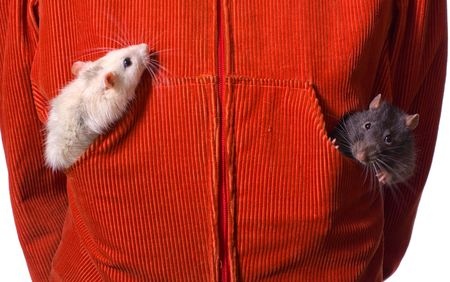Rats With Jacket Fetishes? What Animal Sex Studies Reveal About The Origin Of Unusual Sexual Interests
January 16, 2015 by Justin Lehmiller
Psychologists have discovered that people can develop sexual fetishes for a wide range of objects, with some of the most common being articles of clothing, including underwear, lingerie, and stockings (for a look at some of the more unusual fetishes ever documented, check out this article). But where do these highly specific sexual interests come from in the first place? Scientists have long argued that conditioning processes might serve as a viable explanation, and a growing number studies (mostly focused on animals rather than humans) have supported this view. In this article, we’ll take a look at some of the evidence.
Let’s start with one of the most interesting studies that has ever crossed my desk. In a recent paper published in the journal Physiology & Behavior, scientists essentially tested whether they could condition a clothing fetish in male rats [1]. In one of their experiments, a group of 40 “sexually naïve” (translation: virgin) male rats were assigned to one of two conditions. Half of the rats had their first 9 ejaculatory mating experiences with sexually receptive females while wearing tiny jackets. The other half had their first 9 mating experiences in the buff (i.e., without wearing jackets). For their tenth mating attempt, all of the male rats were randomly assigned to either wear a jacket or not. This means that on the tenth try, some rats that were used to wearing jackets didn’t have them on, while other rats that had never worn jackets were suddenly wearing them.
The researchers found that 100% of the males in the control group (i.e., those that did not wear a jacket for their first 9 mating attempts) successfully mounted, penetrated the female, and ejaculated multiple times on their tenth trial, regardless of whether they wore a jacket or not. So, for rats that had a typical sexual history, putting the jacket on made no difference in their later sexual performance.
Likewise, 100% of the males that trained with the jacket on successfully mounted, penetrated and ejaculated on the tenth try, but only if they were wearing the jacket on that attempt. For the males who trained with the jacket on but had the jacket off for the tenth trial, 80% mounted, 70% penetrated, and just 60% ejaculated. In other words, when the jacket was taken away from those rats that had grown accustomed to wearing it during sex, their sexual performance was impaired. In a sense, then, the researchers conditioned these rats to have a jacket “fetish” of sorts, meaning that for many of them, their sexual performance was contingent upon the presence or absence of this object. It appears that these rats thus came to learn an association between wearing the jacket and sex.
Members of this same research team presented results of an equally fascinating study at the annual meeting of the Society for Neuroscience in 2014. The set-up of the study had a lot of similarities, except that they manipulated whether the rats’ female partners were wearing jackets or not in this case. In the end, they conditioned the male rats to prefer mating with females that were wearing jackets. Thus, the conditioned preference could be for an object the male himself is wearing or something that the female is wearing.
Other research has shown that rats can also develop conditioned preferences for scents [2] and, moreover, that female rats are subject to these conditioning effects as well [3].
Together, all of this research provides strong support for the idea that sensory cues (e.g., sights, sounds, textures) repeatedly paired with sexual behavior and orgasm can become tied to sexual performance in very powerful ways. Of course, the research reviewed here focused on rats, and it should be obvious that rats are not humans; however, there have also been a few experiments conducted with human subjects that are consistent with the conditioning perspective (read more about that research here). In light of this, conditioning would appear to be a potentially viable explanation for the origin of at least some types of fetishes.
Want to learn more about Sex and Psychology? Click here for previous articles or follow the blog on Facebook (facebook.com/psychologyofsex), Twitter (@JustinLehmiller), or Reddit (reddit.com/r/psychologyofsex) to receive updates.
[1] Pfaus, J. G., Erickson, K. A., & Talianakis, S. (2013). Somatosensory conditioning of sexual arousal and copulatory behavior in the male rat: A model of fetish development. Physiology & Behavior, 122, 1-7.
[2] Kippin, T. E., Talianakis, S., Schattmann, L., Bartholomew, S., & Pfaus, J. G. (1998). Olfactory conditioning of sexual behavior in the male rat (Rattus norvegicus). Journal of Comparative Psychology, 112(4), 389-399.
[3] Coria-Avila, G. A., Ouimet, A. J., Pacheco, P., Manzo, J., & Pfaus, J. G. (2005). Olfactory conditioned partner preference in the female rat. Behavioral Neuroscience, 119(3), 716-725.
Image Source: 123RF

Dr. Justin Lehmiller
Founder & Owner of Sex and PsychologyDr. Justin Lehmiller is a social psychologist and Research Fellow at The Kinsey Institute. He runs the Sex and Psychology blog and podcast and is author of the popular book Tell Me What You Want. Dr. Lehmiller is an award-winning educator, and a prolific researcher who has published more than 50 academic works.
Read full bio >


